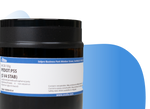ITIC-Th, non-fullerene acceptor with deep energy levels
Low price, high purity (≥99%) ITIC-Th with free shipping on qualifying orders
Specifications | Pricing and Options | MSDS | Literature and Reviews
ITIC-Th (CAS number 1889344-13-1), also known as IT-Th, is an ITIC derivative and a non-fullerene acceptor. Compared with ITIC, instead of having phenyl side-chains, ITIC-Th has hexylthienyl side chains which promotes intermolecular interaction and, therefore, the electron mobility induced by sulfur–sulfur interaction.
High efficient non-fullerene acceptor
with highly conjugated core
Improve electron mobility
Induced by sulfur-sulfur interaction
Worldwide shipping
Quick and reliable shipping
High purity
>99% High purity
ITIC-Th from Ossila was used in the high-impact paper (IF 18.81), Polymorphism in Non-Fullerene Acceptors Based on Indacenodithienothiophene, S. Marina et al., Adv. Funct. Mater., 2103784 (2021); DOI: 10.1002/adfm.202103784.
ITIC-Th also shows lower energy levels (HOMO = −5.66 eV, LUMO = −3.93 eV) than ITIC due to the effect of thienyl side-chains. With even deeper energy levels, it can potentially match the energy levels of most of the high-performance narrow, medium, to wide band-gap polymer semiconductor donors.
Chemical Structure

General Information
| CAS Number | 1889344-13-1 |
| Chemical Formula | C86H74N4O2S8 |
| Purity | >99% (1H NMR) |
| Full Name | 3,9-bis(2-methylene-(3-(1,1-dicyanomethylene)-indanone))-5,5,11,11-tetrakis(5-hexylthienyl)-dithieno[2,3-d:2’,3’-d’]-s-indaceno[1,2-b:5,6-b’]dithiophene |
| Molecular Weight | 1452.05 g/mol |
| HOMO / LUMO | HOMO = -5.66 eV, LUMO = -3.93 eV [1] |
| Solubility | Chloroform, chlorobenzene, dichlorobenzene |
| Synonyms | IT-Th |
| Classification / Family | NFAs, organic semiconducting materials, low band-gap small molecule, small molecular acceptor, organic photovoltaics, polymer solar cells, NF-PSCs, n-type acceptor |
Pricing
| Batch | Quantity | Price |
| M2074A1 | 100 mg | $416 |
| M2074A1 | 250 mg | $832 |
| M2074A1 | 500 mg | $1,417 |
MSDS Documentation
Literature and Reviews
- High-Performance Electron Acceptor with Thienyl Side Chains for Organic Photovoltaics, Y. Lin et al., J. Am. Chem. Soc., 138 (14), 4955–4961 (2016); DOI: 10.1021/jacs.6b02004.
- Ternary Organic Solar Cells Based on Two Compatible Nonfullerene Acceptors with Power Conversion Efficiency >10%, Adv. Mater., 28, 10008–10015 (2016); DOI: 10.1002/adma.201602570.
- Side-Chain Isomerization on an n‑type Organic Semiconductor ITIC Acceptor Makes 11.77% High Efficiency Polymer Solar Cells, Y. Yang et al., J. Am. Chem. Soc., 138, 15011−15018 (2016); DOI: 10.1021/jacs.6b09110.
Related Products
Semiconducting polymers for bulk heterojunction, OPV, OLED, OFET and perovskite interfaces and solar cell research.


 ITIC-Th MSDS Sheet
ITIC-Th MSDS Sheet
